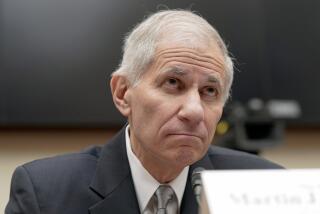Deposit Insurance Fund Losses Seen Climbing Sharply
- Share via
WASHINGTON — Federal regulators on Wednesday sharply increased their estimate of losses for the ailing fund that insures bank deposits, saying its deficit could hit $14.1 billion this year and soar to $28.9 billion by the end of 1993.
The Federal Deposit Insurance Corp., which made the disclosure in a letter to Sen. Banking Committee Chairman Donald W. Riegle (D-Mich.), also warned that a plan before Congress to borrow $30 billion to rebuild the fund may be insufficient if bank losses keep mounting.
“If the banking industry deteriorates further, $30 billion will probably not be sufficient,” FDIC acting Chairman Andrew Hove said in the letter. “Attempting to be more specific at this time would be speculative at best.”
The FDIC had estimated in June that the fund deficit was likely to be $3 billion next year, with a pessimistic scenario calling for an $11-billion deficit. Wednesday’s revised estimate for deficits ranges from $9.6 billion to $14.1 billion, indicating a substantially more pessimistic view has emerged in the last three months.
The agency, which protects depositors’ funds up to $100,000, also offered its first forecast for 1993, with the fund’s deficit probably at $18.3 billion to $28.9 billion.
The FDIC predicts that 200 to 239 banks, with total assets ranging from $86 billion to $116 billion, will fail next year, up from an estimated 180 failures with assets of $80 billion this year. There is no estimate for the number of institutions expected to fail in 1993, but assets will range from $82 billion to $120 billion.
The agency revises its bank failure estimates periodically, and the gloomy new figures were prompted by the sluggish economy and the deep recession in real estate. Loans for real estate are the biggest single source of business for the nation’s banks, and the decline in real estate prices means that many borrowers will be unable to repay their loans.
The fund is financed by premiums paid by the banks, and both the industry and the Bush Administration have insisted that a taxpayer bailout will not be needed.
The FDIC board will consider a premium increase next year. The agency has the difficult task of extracting revenues from the industry for the insurance fund, without raising premiums so high that they threaten the financial solvency of some weaker banks.
The new estimates on the bank fund’s condition drew sharp criticism from Rep. Frank Annunzio (D-Ill.), chairman of the financial institutions subcommittee of the Banking Committee and a critic of L. William Seidman, who completed his term last week as FDIC chairman.
“I’ve been saying that the fund is in worse condition for two years, but the snake oil salesman who headed the FDIC would not admit it,” Annunzio said. “Isn’t it strange that the minute he is out of office, the truth comes out? We must recapitalize the FDIC fund immediately and at no cost to the taxpayers.”
The insurance fund is in “urgent” need of new money, acting FDIC Chairman Hove said in the letter to Riegle. The fund “will reach its debt limitation in the very near future.”
The $30 billion in new borrowing authority for the FDIC is included in a major bank reform bill now awaiting action by the full House and Senate.
The House could vote next week on a compromise version of the reform bill that would allow interstate banking and give banks broader access to the securities business under strict controls. However, it would eliminate the Administration plan to allow commercial and industrial firms to own banks. Senate action on the reform bill has not yet been scheduled.
If it appears that comprehensive legislation cannot be easily approved in both houses of Congress, the lawmakers will feel considerable pressure to pass a stripped-down bill that rescues the bank insurance fund.
More to Read
Inside the business of entertainment
The Wide Shot brings you news, analysis and insights on everything from streaming wars to production — and what it all means for the future.
You may occasionally receive promotional content from the Los Angeles Times.










